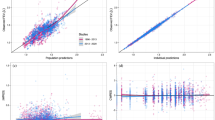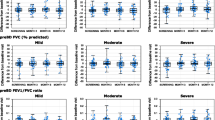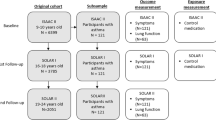Abstract
Asthma is an obstructive lung disease where the mechanism of disease progression is not fully understood hence motivating the use of empirical models to describe the evolution of the patient’s health state. With reference to placebo response, measured in terms of FEV1 (Forced Expiratory Volume in 1 s), a range of empirical models taken from the literature were compared at a single trial level. In particular, eleven GSK trials lasting 12 weeks in mild-to-moderate asthma were used for the modelling of longitudinal placebo responses. Then, the chosen exponential model was used to carry out an individual participant data meta-analysis on eleven trials. A covariate analysis was also performed to find relevant covariates in asthma to be accounted for in the meta-analysis model. Age, gender, and height were found statistically significant (e.g. the taller the patients the higher the FEV1, the older the patients the lower the FEV1, and females have lower FEV1). By truncating each trial at week 4, the predictive properties of the meta-analysis model were also investigated, showing its ability to predict long-term FEV1 response from truncated trials. Summarizing, the study suggests that: (i) the exponential model effectively describes the placebo response; (ii) the meta-analysis approach may prove helpful to simulate new trials as well as to reduce trial duration in view of its predictive properties; (iii) the inclusion of available covariates within the meta-analysis model provides a reduction of the inter-individual variability.









Similar content being viewed by others

References
American Lung Association (2007) Trends in asthma morbidity and mortality. American Lung Association Epidemiology & Statistics Unit Research and Program Services
Miller MR, Hankinson J, Brusasco V et al (2005) Standardisation of spirometry. Eur Respir J 26:319–338. doi:10.1183/09031936.05.00034805
Pierce R (2005) Spirometry: an essential clinical measurement. Aust Family Phys 34:535–539
American Thoracic Society (1991) Lung function testing: selection of reference values and interpretative strategies. Am Rev Respir Dis 144:1202–1218
Wagner NL, Beckett WS, Steinberg R (2006) Using spirometry results in occupational medicine and research: common errors and good practice in statistical analysis and reporting. Indian J Occup Environ Med 10:5–10. doi:10.4103/0019-5278.22888
David PJ, Pierce R (2008) Spirometry handbook, 3rd edn., Spirometry: the measurement and interpretation of ventilatory function in clinical practiceNational Asthma Campaign, Melbourne, pp 1–24
Gomeni R, Merlo-Pich E (2006) Bayesian modelling and ROC analysis to predict placebo responders using clinical score measured in the initial weeks of treatment in depression trials. Br J Clin Pharmacol 63:595–613. doi:10.1111/j.1365-2125.2006.02815.x
Nucci G, Gomeni R, Poggesi I (2009) Model-based approaches to increase efficiency of drug development in schizophrenia: a can’t miss opportunity. Expert Opin Drug Discov 4:837–856. doi:10.1517/17460440903036073
Holford N, Li J, Benincosa L, Birath M (2002) Population disease progress models for the time course of HAMD score in depressed patients receiving placebo in anti-depressant clinical trials. Population Approach Group in Europe (PAGE) 11th Meeting, Abstract 311. http://www.page-meeting.org/?abstract=311
Reddy VP, Kozielska M, Johnson M, Vermeulen A, de Greef R, Liu J, Groothuis GMM, Danhof M, Proost JH (2011) Structural models describing placebo treatment effects in schizophrenia and other neuropsychiatric disorders. Clin Pharmacokinet 50:429–450. doi:10.2165/11590590-000000000-00000
Russu A, Marostica E, De Nicolao G, Hooker AC, Poggesi I, Gomeni R, Zamuner S (2012) Joint modeling of efficacy, dropout, and tolerability in flexible-dose trials: a case study in depression. Clin Pharmacol Ther 91:863–871. doi:10.1038/clpt.2011.322
Atkinson AJ, Huang SM, Lertora JJL, Markey SP (2012) Principles of clinical pharmacology. Academic Press, London
Shang EY, Gibbs MA, Landen JW, Krams M, Russell T, Denman NG, Mould DR (2009) Evaluation of structural models to describe the effect of placebo upon the time course of major depressive disorder. J Pharmacokinet Pharmacodyn 36:63–80. doi:10.1007/s10928-009-9110-3
Matre D, Casey KL, Knardahl S (2006) Placebo-induced changes in spinal cord pain processing. J Neurosci 26:559–563. doi:10.1523/JNEUROSCI.4218-05.2006
Mayberg HS, Silva JA, Brannan SK, Tekell JL, Mahurin RK, McGinnis S, Jerabek PA (2002) The functional neuroanatomy of the placebo effect. Am J Psychiatry 159:728–737
de la Fuente-Fernandez R, Ruth TJ, Sossi V, Schulzer M, Calne DB, Stoessl AJ (2001) Expectation and dopamine release: mechanism of the placebo effect in Parkinson’s disease. Science 293:1164–1166. doi:10.1126/science.1060937
Delahoy P, Thompson S, Marschner IC (2010) Pregabalin versus gabapentin in partial epilepsy: a meta-analysis of dose–response relationships. BMC Neurol 10:104. doi:10.1186/1471-2377-10-104
Houk BE, Bello CL, Kang D, Amantea M (2009) A population pharmacokinetic meta-analysis of sunitinib malate (SU11248) and its primary metabolite (SU12662) in healthy volunteers and oncology patients. Clin Cancer Res 15:2497–2506. doi:10.1158/1078-0432.ccr-08-1893
Chan PL, Weatherley B, McFadyen L (2008) A population pharmacokinetic meta-analysis of maraviroc in healthy volunteers and asymptomatic HIV-infected subjects. Br J Clin Pharmacol 65:76–85. doi:10.1111/j.1365-2125.2008.03139.x
Ito K, Ahadieh S, Corrigan B, French J, Fullerton T, Tensfeld T (2010) Disease progression meta-analysis model in Alzheimer’s disease. Alzheimers Dement 6:39–53. doi:10.1016/j.jalz.2009.05.665
Forey BA, Thornton AJ, Lee PN (2011) Systematic review with meta-analysis of the epidemiological evidence relating smoking to COPD, chronic bronchitis and emphysema. BMC Pulm Med 11:36. doi:10.1186/1471-2466-11-36
Wang X, Shang D, Ribbing J, Ren Y, Deng C, Zhou T, Guo F, Lu W (2012) Placebo effect model in asthma clinical studies: longitudinal meta-analysis of forced expiratory volume in 1 second. Eur J Clin Pharmacol 68:1157–1166. doi:10.1007/s00228-012-1245-2
Rowland M, Sheiner LB, Steimer JL (1985) Variability in drug therapy: description, estimation and control. Raven Press, New York
Lunn DJ, Thomas A, Best N, Spiegelhalter DJ (2000) WinBUG: a Bayesian modeling framework: concepts, structure and extensibility. Stat Comput 10:325–337
Development Core Team R (2011) R: a language and environment for statistical computing. R Foundation for Statistical Computing, Vienna
Spiegelhalter DJ, Best NG, Carlin BP, van der Linde A (2002) Bayesian measures of model complexity and fit. J R Statist Soc B 64(Part 4):583–639. doi:10.1111/1467-9868.00353
Karlsson M, Holford N (2008) A tutorial on Visual Predictive Checks. Population Approach Group in Europe (PAGE) 17th Meeting, Abstract 1434. http://www.page-meeting.org/default.asp?abstract=1434
Sheiner LB, Beal SL (1981) Some suggestions for measuring predictive performance. J Pharmacokinet Biopharm 9:503–512
Fisher RA (1925) Statistical methods for research workers. Oliver & Boyd, Edinburgh
Ette EL, Williams PJ (2013) Pharmacometrics: the science of quantitative pharmacology. Wiley, Hoboken
Barraclough KA, Isbel NM, Kirkpatrick CM, Lee KJ, Taylor PJ, Johnson DW, Campbell SB, Leary DR, Staatz CE (2011) Evaluation of limited sampling methods for estimation of tacrolimus exposure in adult kidney transplant recipients. Br J Clin Pharmacol 71:207–223. doi:10.1111/j.1365-2125.2010.03815.x
Sasakawa T, Masui K, Kazama T (2013) Iwasaki H. Comparison of Five Parameter Sets. American Society of Anesthesiologists, Performance of Compartmental Pharmacokinetic Model for Rocuronium
Acknowledgments
The authors thank colleagues in the Respiratory Therapeutic Area in particular Shuyen Ho and Anna Ellsworth who supported preparation of the database for this work.
Author information
Authors and Affiliations
Corresponding author
Rights and permissions
About this article
Cite this article
Marostica, E., Russu, A., Yang, S. et al. Population model of longitudinal FEV1 data in asthmatics: meta-analysis and predictability of placebo response. J Pharmacokinet Pharmacodyn 41, 553–569 (2014). https://doi.org/10.1007/s10928-014-9373-1
Received:
Accepted:
Published:
Issue Date:
DOI: https://doi.org/10.1007/s10928-014-9373-1



